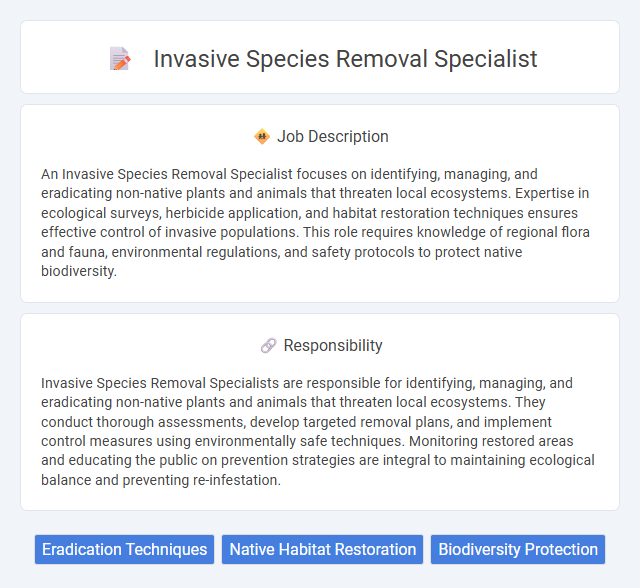
An Invasive Species Removal Specialist focuses on identifying, managing, and eradicating non-native plants and animals that threaten local ecosystems. Expertise in ecological surveys, herbicide application, and habitat restoration techniques ensures effective control of invasive populations. This role requires knowledge of regional flora and fauna, environmental regulations, and safety protocols to protect native biodiversity.
Individuals who are physically fit and comfortable working outdoors in varying weather conditions are likely suitable for an Invasive Species Removal Specialist role. Those with a background or willingness to learn about environmental science and plant identification may adapt well to the job requirements. People who prefer routine indoor work or have limited mobility might find this position challenging.
Qualification
Invasive Species Removal Specialists must possess strong knowledge of local ecosystems and invasive species identification to effectively manage and eliminate harmful organisms. Proficiency in the safe use of herbicides, pesticides, and removal tools, alongside certification in environmental safety and hazardous material handling, is essential. Experience in ecological restoration and adherence to regulatory standards ensure successful habitat rehabilitation and biodiversity preservation.
Responsibility
Invasive Species Removal Specialists are responsible for identifying, managing, and eradicating non-native plants and animals that threaten local ecosystems. They conduct thorough assessments, develop targeted removal plans, and implement control measures using environmentally safe techniques. Monitoring restored areas and educating the public on prevention strategies are integral to maintaining ecological balance and preventing re-infestation.
Benefit
Hiring an Invasive Species Removal Specialist likely increases the probability of effective eradication of harmful non-native plants or animals, preventing further damage to local ecosystems. Their expertise probably supports the restoration of native biodiversity and enhances ecosystem resilience. Investing in their services may reduce long-term environmental management costs by controlling invasive populations early.
Challenge
Invasive Species Removal Specialists likely face significant challenges due to the complexity of identifying and eradicating non-native organisms without harming native ecosystems. The difficulty in accessing remote or sensitive habitats may increase the probability of physical strain and environmental impact. Managing persistent and rapidly spreading species could require adaptive strategies and continuous monitoring to ensure successful long-term containment.
Career Advancement
Invasive Species Removal Specialists play a crucial role in ecosystem restoration by identifying and eradicating harmful non-native plants and animals. Career advancement opportunities include progressing to senior ecological restoration roles, project management positions, and environmental consulting, often requiring certifications in invasive species management or advanced degrees in environmental science. Gaining expertise in geographic information systems (GIS) and leadership skills significantly enhances promotion prospects within environmental agencies and conservation organizations.
Key Terms
Eradication Techniques
Invasive Species Removal Specialists utilize advanced eradication techniques such as chemical treatments, mechanical removal, and biological control to eliminate non-native pests effectively. Precise identification of invasive species informs the selection of targeted methods, minimizing collateral damage to native ecosystems. Continuous monitoring and adaptive management practices ensure long-term success in restoring natural habitats and preventing species reintroduction.
Native Habitat Restoration
Invasive Species Removal Specialists play a crucial role in restoring native habitats by identifying and eradicating non-native plants and animals that threaten local ecosystems. Their expertise supports the recovery of biodiversity, improves soil health, and promotes the regeneration of native flora and fauna. Effective invasive species management ensures long-term ecological balance and sustains the natural resources vital to wildlife and human communities.
Biodiversity Protection
Invasive Species Removal Specialists play a crucial role in biodiversity protection by identifying and eradicating non-native plants and animals that disrupt ecosystems. Their expertise in ecological assessment and habitat restoration helps preserve native species diversity and ensures the stability of local ecosystems. Efficient removal techniques prevent the spread of invasive species, supporting the recovery of endangered flora and fauna populations.
 kuljobs.com
kuljobs.com